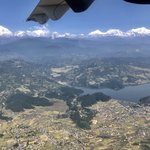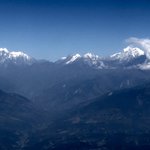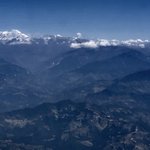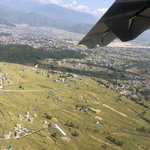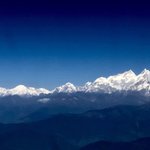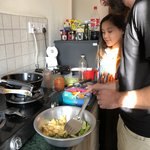Highlights
- The mountain views are best in the winter, with clear weather almost guaranteed
- Enjoy some of the most popular treks in Nepal, such as Poon Hill, crowd-free
- Get a great bargain on nicer hotels in the low season
- Despite the cold nights, the sunny winter days are great for trekking
Overview
Although spring and autumn are the most popular times to visit Nepal, trekking in the winter has its distinct advantages. It rarely rains in December, January and February, so the skies will be crisp and clear. This means the mountain views will be at their best. Because winter is considered the off-season, you will have no trouble getting a bed at teahouses (or cheaper rooms in Nepal’s cities). Plus, the trails will be less crowded, meaning you will have those clear views almost to yourself.
While Nepal’s lower elevations never get especially cold (cities like Kathmandu and Pokhara never see snow), the higher you go, the colder the temperatures. This means that some higher-elevation treks are not ideal in the winter, and some will be impassable with snow. Treks that stay below 4000 meters will be more comfortable, as well as safer. Also, Nepal’s winter is fairly short, so if you visit Nepal in early December or late February, you will likely see mild-to-warm temperatures.
Winter temperatures
| Location | December | January | February |
|---|---|---|---|
| Kathmandu | 46-70°F (8-21°C) | 40-62°F (4-17°C) | 40-67°F (4-19°C) |
| Pokhara | 46-70°F (8-21°C) | 45-66°F (7-19°C) | 48-70°F (9-21°C) |
| Namche Bazaar | 20-45°F (-6.50-7.6°C) | 18-43°F (-8-6°C) | 21-43°F (-6-6°C) |
| Jomsom | 32-59°F (0-15°C) | 32-53°F (0-12°C) | 33-55°F (1-13°C) |
| Chitwan | 46-75°F (8-24°C) | 44-75°F (7-24°C) | 46-79°F (8-26°C) |
| *Temperatures shown are average min/max tempartures for those months | |||
Chat with a local specialist who can help organize your trip.
Everest Panorama Trek
While it is possible to trek all the way to Everest Base Camp in the winter, the high altitude (5335 meters) makes this trek even more challenging in the winter due to the cold temperatures. For a more comfortable taste of the Everest region, you could try one of the shorter treks nearby.
With five days, you can fly from Kathmandu to Lukla, and then trek to Namche Bazaar, the bustling heartland of Sherpa culture. With Namche as your base, you can hike to the beautiful village of Thame, with a picturesque monastery perched high up on the cliffs. With seven days, you can continue on to Tengboche.
In Tengboche, you can visit the famous monastery of Dawa Choling Gompa, where climbers and trekkers traditionally visit the Head Lama to receive his blessings for a successful trip. Tengboche also offers extraordinary close-up views of Ama Dablam, a deserving candidate for the world’s most beautiful mountain. More details
Poon Hill Trek
In peak season, the Poon Hill trek (passing through Ghorepani and Ghandruk) is extremely popular, and you may need to jostle for space at the dawn lookout point. Not in the winter! This trek is a popular classic for good reason: you will pass through local villages, forests with a range of vegetation, and enjoy spectacular sunrise views at Poon Hill (3210 meters). A major advantage of this trek is that it’s easily accessible and offers some very close-up views of the high Himalaya, such as Annapurna and Dhaulagiri, without needing to ascend too high. Perfect for the winter season! More details
Khopra Danda Trek
While the Poon Hill trek can be done in as little as three days, if you have more time you can add on the Khopra Danda extension. It’s a lesser-known trek even in the peak seasons, so during the winter you are likely to have the trails all to yourself. The route follows the same path as the Poon Hill trek for the first couple of days, before a local trail takes you down into the valley north of Ghorepani, before climbing up to Khopra Ridge (3640 meters). You’ll have great views of peaks such as Annapurna, Dhaulagiri and Machhapuchhre (Fishtail) on this trek. More details
Kathmandu Valley Trek
The Kathmandu Valley stays relatively mild throughout the winter, making it an ideal place to enjoy some shorter hikes at lower altitude. A great 2-3 day trek will take you from Kathmandu city to Nagarkot, then on to Dhulikhel and down to Bhaktapur. Nagarkot and Dhulikhel are old Newari towns just outside the Valley, and when the weather is clear, as it should be in the winter, the Himalayan views are spectacular. There are a variety of cozy guesthouses and homestays in both places, to suit any budget. For a luxurious experience, try Dwarika’s Dhulikel; for a more budget-friendly option, head to the Nagarkot Farmhouse.
There are plenty of good day hikes around the Kathmandu Valley, as well, allowing you to return to your well-heated Kathmandu hotel at the end of each day. The Valley’s highest peaks, such as Phulchoki and Champadevi, make for good, challenging day hikes with spectacular city and mountain views, as does a hike in the Shivapuri National Park. More details
Chitwan
For something a little different, head south to the Chitwan National Park on Nepal’s flat plains, where it never gets too cold. While most tourists come to see the elephants and rhinos in the park, there are also some good hiking options. The Chitwan Hills Trail takes you to Siraichuli Hill, one of the highest hills in the Mahabharat range (1,945 meters). From there, sunrise and sunset is especially spectacular, and the views take in the plains as well as Himalayan peaks in the distance. Here's a recommended 12 day itinerary that includes Chitwan along with a short trek in the Pokhara area.
Recommended clothing
Preparation for all weather is necessary when trekking in Nepal at any time of year, but in the winter it is especially important to have enough warm layers. Daytime temperatures in Nepal can be warm in winter, yet drop to below freezing at higher elevations. You will likely need to take your coat off during the day while you’re trekking, so a good down coat is ideal. Down jackets are light to carry and will keep you warm when the sun goes down. Good woollen hats, gloves, socks and scarves are also essential.
Almost all winter equipment can be bought or rented at one of trekking shops in Thamel, Kathmandu. Depending on how long you’ll be trekking for and how cold it gets, it doesn’t hurt to bring your own winter gear, as well. While teahouses provide blankets, if you have a compact sleeping bag of your own, it is advisable to bring this for extra warmth.
Here’s a helpful list of essential winter gear to bring to Nepal:
- A warm winter sleeping bag (ideally down)
- A few pairs of warm socks
- Layers (t-shirt, long-sleeved, and down jacket)
- A pair of warm gloves and a toque
- Sunscreen and sunglasses

